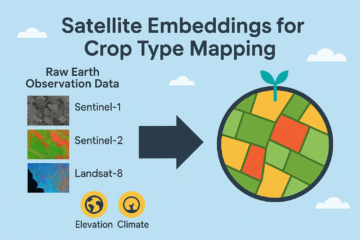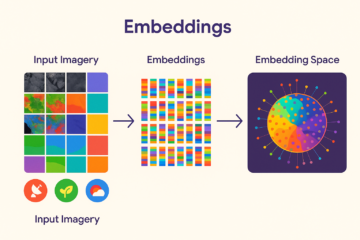The Earth Observation (EO) industry is entering a new era shaped by Artificial Intelligence (AI). At the centre of this change are foundation models—large, pre-trained AI models capable of learning from vast global datasets and being applied almost anywhere in the world. These models promise to move EO from being data-heavy and fragmented to becoming scalable, interoperable, and insight-driven.
Foundation Models: A Global Shift
Unlike traditional supervised models that demand significant training data for each new location or sensor, foundation models can be applied with limited or even zero additional training. While they may not yet outperform conventional approaches, the gap is closing quickly thanks to ongoing pre-training and fine-tuning efforts. The future is bright: models trained globally will unlock consistent, high-quality insights at local scales.
Open-Source for Wider Impact
One of the most exciting trends is the rise of open-source foundation models. By lowering computational costs, these models will empower universities, research centres, and government agencies to harness advanced AI without the heavy infrastructure usually required. With such access, communities will be able to build specialised tools and applications on top of these baselines, much like today’s wave of innovations built around ChatGPT.
AI Onboard Satellites
A major development will be the integration of AI directly into satellites. Imagine a sensor in orbit not just collecting raw data but interpreting it in real time. This could allow farmers to receive crop stress alerts instantly, or disaster managers to gain rapid situational awareness during floods and wildfires. Moving processing closer to the sensor reduces latency and accelerates decision-making when every minute matters.

Towards Sensor-Agnostic Models
Currently, each satellite sensor requires its own preprocessing—different spectral bands, atmospheric corrections, and resolutions complicate workflows. With hyperspectral and other new sensors launching almost weekly, this is becoming unsustainable. The industry needs sensor-agnostic foundation models that work seamlessly across datasets. Emerging standards will make this possible, enabling consistent analysis across missions and shifting providers towards delivering data products rather than raw imagery.
Building Trust with Explainable AI
As AI becomes embedded in EO systems, trust and transparency will be critical. Users need to understand why a model produced a certain result. Explainable AI will provide classifications along with reasoning—for instance, if an area is flagged as experiencing drought stress, the model could explain the spectral indicators that led to that conclusion. This not only prevents “hallucinated” results but also gives decision-makers confidence in the insights.

Democratising EO with Prompt-to-Code
Another future trend is prompt-to-code capability. Users will be able to describe their needs in plain English—such as “map flood risk zones for Norfolk”—and AI will generate the necessary tool or API automatically. This will democratise software development, allowing non-specialists to build solutions on top of EO platforms. As a result, innovation will accelerate and more open-source EO tools will emerge.
Towards Interoperable Platforms
Ultimately, AI will help resolve one of the industry’s biggest bottlenecks: compatibility across diverse sensors and platforms. By embedding AI at the software core, workflows will become unified, interoperable, and user-friendly. This evolution will expand EO’s impact, from agriculture and finance to climate resilience and disaster risk reduction.
Conclusion
AI, and particularly foundation models, are not just incremental improvements—they are reshaping the EO ecosystem itself. With open-source adoption, onboard integration, explainable outputs, and sensor-agnostic standards, the sector is moving towards a future where data is seamlessly transformed into actionable insights. The challenge now is not whether this change will happen, but how quickly we can adapt to make the most of it.




1 Comment
Ajithkumar · 1 September 2025 at 18:19
Thanks for this informative post!